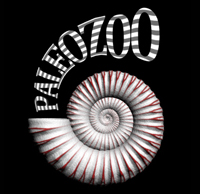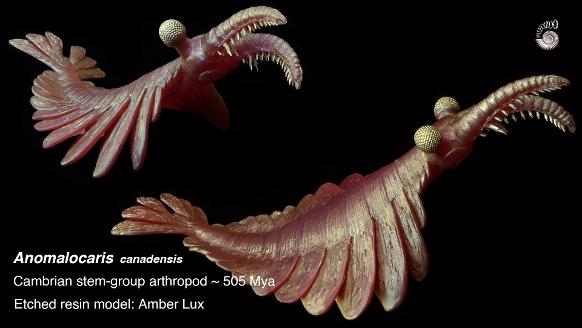Anomalocaris canadensis is an extinct stem-group arthropod from the Cambrian period and it is one of the most famous and intriguing organisms in all of paleontology. Its unusual morphology has puzzled paleontologists for many decades. Anomalocaris was a giant of its time - growing up to 1 metre in length - and is now thought to have been one of nature's first apex predators.
Anomalocaris's unusual morphology includes interleaving lobes along the side of its body, stalked compound eyes, a circular plate-rimmed mouth and a pair of distinctive grasping forelimbs (Daley, Edgecombe, 2014),
Disembodied parts of a species of Anomalocaris were discovered in the Burgess Shale deposits of British Columbia, Canada and they were initially thought to be the remains of several different creatures. Subsequent finds however revealed that the separate parts belonged to one large creature – Anomalocaris (Whittington, Briggs, 1985). It soon became clear that Anomalocaris was probably a highly manoeuverable creature with excellent vision and an ability to attack and hold prey.

Anomalocaris has a segmented body and was able to propel itself through the water by undulating a series of flexible overlapping (imbricating) lobes that ran down each side of its body (13 per side with 3 additional neck lobes). The underside of each lobe was covered with a striated gill-like structure presumably for filtering oxygen.
The body was predominantly soft and flexible but some sections were partially hardened - a sclerotized head cap, cheek and fore-limbs - possibly as self-protection. Anomalocaris was probably very agile using its distinctive fan-like tail in much the same way as modern birds (Sheppard et al. 2018).

Anomalocaris's distinctive forelimbs were each made up of approximately 14 sections (podomeres) with each section containing two ventral barbs (endites) and most barbs containing a further two tripod-like spikes. These barbed fore-limbs are thought to have been used to grab smaller arthropods and then to flex and crack them apart before enfolding them down towards the circular mouth with its serrated plates. Although the mouth parts were probably not strong enough to bite through hardened shell they would have been able to slice at exposed flesh.
Recent discoveries from the Emu Bay Shale of Kangaroo Island, South Australia confirm that anomalocarids had remarkable compound eyes (Paterson et al. 2011) - far more powerful than those of contemporaneous trilobites and comparable to modern dragonflies. These stalked compound eyes would have provided excellent 360 degree vision and they add to the impression of Anomalocaris being an agile predator. This discovery also helped to finally classify Anomalocaris as a stem-group arthropod rather than it belonging to an unknown extinct phylum.

It is noteworthy that such complex eyes evolved so early on in the history of animal evolution - before segmented legs or hardened shells - and with the ability to see in colour (Fleming et al. 2018) it suggests that the Cambrian environment was very dynamic and suffuse with colour.

Anomalocaris is of significant interest to paleontology because it was one of the earliest and most complex predators in Earth's history, representing a key stage in the evolution of marine ecosystems during the Cambrian Explosion
There is still debate about whether the protective shell-like structures of many Cambrian organisms evolved as a response to predation from creatures like Anomalocaris or whether it had other causal factors. What is clear though, is that hardened body parts and complex predation both appeared at around the same time during the Cambrian period.

With thanks to Dr Jean-Bernard Caron for assistance with anatomical detail.






